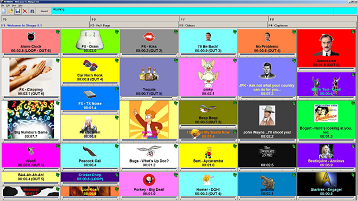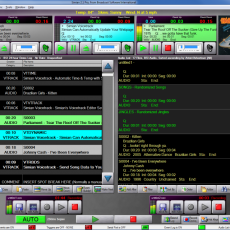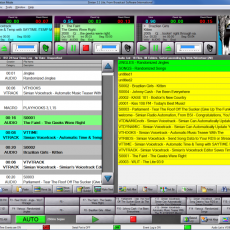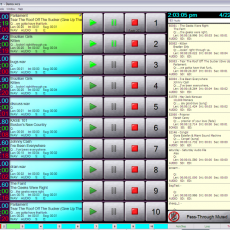Description
Instant Record and Replay
Stinger 3.1 provides instant playback of up to 1152 audio files at the touch of a button!
Stinger 3.1 has a new record functionality that is as easy to use as its playback feature.
Customer Comment: “My Jox are really happy that I got the program; they are taking it like a duck to water. It is adding another dimension to their shows and also giving them the tools to step up a level.”
Stinger 3.1 is far less expensive than any of those “instant audio” hardware boxes, but has much more capability and versatility.
Customer Comment: “I just wanted to drop you a line and say how much I love Stinger. I have been using it for over a year… …it has never let me down.”
Stinger 3.1 is perfect for fast-paced morning shows, DJs that want to add a bit of spice to their shows, stadium announcers, audio production directors, cat-walk shows, theatre groups, corporate presentations… the list goes on!
Stinger 3.1 was designed by broadcast professionals with years of experience, as a creative tool for the playback and recording of short-length effects, drop-ins, liners, jingles and other audio elements.Stinger 3.1 can play multiple files at the same time on a single audio card, or on up to 6 outputs on multi-channel audio cards (requires a WAVE or WDM audio card).
Customer Comment: “I drive Stinger with a 19″ ELO Touch Screen…..What a combination!”
Up to 1152 audio cuts are instantly available, each with a user-defined background color and caption making it easy to find the right buttons. There’s no scrolling through a tiny view Window, Stinger will resize to the size of your PC monitor.
You can save multiple collections of audio files (or individual sets) for Instant Recall – so each daypart or production can have their own buttons.
Stinger 3.1 is touch-screen compatible or can be operated from the keyboard, or mouse.
With support for dual monitors, Stinger 3.1 is capable of having up to 144 buttons on-screen at any one time.
All software licenses are non-transferable, unless approved by BSI in advance.
System Requirements
Stinger 3.1 will run on a wide variety of platforms – anything from a Core i machine should be suitable. However, for reliable 24/7 operation we recommend using a Core i5 CPU with 8Gb+ of RAM running Windows 10 or 11 Pro 64bit. SATA disk-based hard drives have proven to be the most reliable.
Pitfalls to Avoid:
We have put together a list of some of the major pitfalls to avoid when building your own system:
- Any server based operating system (including Windows 2003, 2008, 2012), Windows Vista, or any OS older than Windows 10; our supported operating systems are Windows 10 or 11 Pro 64bit. No other operating systems (including any version of Windows Home or Media, or any of the Vista versions) are supported.
- File should be played off the LOCAL PC’s hard drive, not across a network or from a file server
- A file server is neither desired nor required, may decrease performance and introduces a single point of failure. We supply configuration instructions for a fully redundant networked system, with software file-mirroring suitable for an Air and production system, or multiple workstations.
- Intel Celeron, Pentium, or AMD Processors (or emulated PCs) – use Genuine Intel Core 2 Duo, Core i series, or Xeon series or above CPUs
- USB, Firewire or other external storage devices
- SCSI or IDE drives – use SATA 6Gb/s drives for best performance; using seperate hard-drives for Windows and Audio Files can also help in a number of ways.
- Software RAID Arrays – these can be detrimental to performance, place additional requirements on your computer system, and often make it more difficult to rebuild or restore a machine. They also do nothing to Protect against viruses or accidental deletion of files (our Second Copy software file mirroring keeps multiple copies of deleted files safely).
- SSD Drives – Using SSDs in an automation computer is known to cause playback issues because of the way they function. SSDs are not made for the constant read/write functionality required of an automation system. To reduce wear on the memory cells, SSDs purposefully move around written data and reduce read/write bandwidth and will over the course of hours or days reduce bandwidth so severely that the buffering of audio data can not occur at a rate faster than playback requires, causing stuttering audio or delayed performance and responsiveness. BSI does not support running software on a computer that has SSDs for any of its drives. Only conventional HDD systems are supported.
- ‘Cheap’ or non-branded memory – make sure you use a brand recommended by your motherboard manufacturer. 2GB is enough for basic operation on Windows 7 or above with no other applications running (even in the background), but we’re now fitting 8GB as standard to the machines we supply.
- Flimsy, thin cases with little RF shielding (often consisted mainly of plastic and with poor air circulation). A good technical ground is essential in a professional broadcast environment.
- Consumer Grade Audio Cards – BSI products are designed and tested to work with AudioScience and IP Audio drivers–such as Axia, WheatNet and Dante–to ensure reliable 24×7 operation.
- USB/Firewire external audio devices
- Drivers or Software Updates not yet certified by BSI. Manufacturers will often make newer drivers and utilities available on their web sites prior to them being fully tested by BSI. You can find the latest recommended drivers and utilities listed on our Latest Drivers web page.



